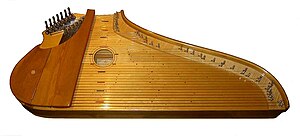Kantele

A kantele (Finnish: [ˈkɑntele]) or harppu (in Sami)[1] is a traditional plucked string instrument of the dulcimer and zither family native to Finland and Karelia. Its relatives can be found throughout the world, including Estonian kannel, Mari kusle, Russian gusli, Latvian kokle, and Lithuanian kanklės. Together these instruments make up the family known as Baltic psalteries. Kantele is also related to the ancient Asian instruments such as Uyghur kanun, Chinese guzheng, Japanese koto, and Korean gayageum.
Construction
Small kantele

Modern instruments with 15 or fewer strings are generally more closely modeled on traditional shapes, and form a category of instrument known as small kantele, in contrast to the modern concert kantele.
The oldest forms of kantele have 5 or 6 horsehair strings and a wooden body carved from one piece; more modern instruments have metal strings and often a body made from several pieces. The traditional kantele has neither bridge nor nut, the strings run directly from the tuning pegs to a metal bar (varras) set into wooden brackets (ponsi). Though not acoustically efficient, this construction is part of the distinctive sound of the kantele.[2]
The most typical and traditional tuning of the five-string small kantele is just intonation arrived at via five point tuning, often in d major or d minor. This occurs especially if kantele is played as a solo instrument or as a part of a folk music ensemble. The major triad is then formed by d1–f♯1–a1.[3] In modern variants of small kantele, there are often semitone levers for some strings. Most typical is the lever for a five string kantele is a switch between f♯1 and f1, which allows most of the folk music to be played without retuning. Larger small kanteles very often have also other semitone levers that allow more varied selection of music to be played without retuning.
Concert kantele
Modern concert kantele can have up to 40 strings. The playing positions of concert kantele and small kantele are reversed: to the player of a small kantele the longest low pitched strings are farthest away from his body, whilst to a concert kantele this side of the instrument is nearest, and the short high pitched strings farthest away. Concert versions have a switch mechanism (similar to semitone levers on a modern folk harp) for making sharps and flats, an innovation developed introduced by Paul Salminen in the 1920s.[4]
Playing

The kantele has a distinctive bell-like sound. The Finnish kantele generally has a diatonic tuning though small kantele with between 5 and 15 strings are often tuned to a gapped mode missing a seventh and with the lowest pitched strings tuned to a fourth below the tonic as a drone. Players hold the kantele in their laps or on a small table. There are two main techniques to play, either plucking the strings with their fingers or strumming unstopped strings (sometimes with a matchstick).[2] The small and concert kanteles have different, though related, repertoires.
Music

There have been strong developments for the kantele in Finland since the mid-20th century, starting with the efforts of modern players such as Martti Pokela in the 1950s and 1960s. Education for playing the instrument starts in schools and music institutes up to conservatories and the Sibelius Academy, the only music university in Finland. Even some artistic doctoral studies have been made at the Academy with traditional, western classical and electronic music. A Finnish luthiery, Koistinen Kantele,[5] has developed also an electric kantele, which employs pick-ups similar to those on electric guitars. It has gained popularity amongst Finnish heavy metal musicians such as Amorphis.
Legendary history

In Finland's national epic, Kalevala, the mage Väinämöinen makes the first kantele from the jawbone of a giant pike and a few hairs from Hiisi's stallion. The music it makes draws all the forest creatures near to wonder at its beauty. \
Later, after losing and greatly grieving over his kantele, Väinämöinen makes another one from a birch, strung with the hair of a willing maiden, and its magic proves equally profound. It is the gift the eternal sage leaves behind when he departs Kaleva at the advent of Christianity.[6]
See also
References
- ^ Ling, Jan (1997). A history of European folk music. University Rochester Press. p. 7. ISBN 978-1-878822-77-2. Retrieved 29 May 2011.
- ^ a b Broughton, Simon; Ellingham, Mark; Trillo, Richard (1999). World Music: Africa, Europe and the Middle East. Rough Guides. p. 93. ISBN 978-1-85828-635-8. Retrieved 17 June 2012.
- ^ Kantele. Etno.net. Sibelius-Akatemia. Retrieved 2015-08-28.
- ^ Ramnarine, Tina K. (1 August 2003). Ilmatar's Inspirations: Nationalism, Globalization, and the Changing Soundscapes of Finnish Folk Music. University of Chicago Press. p. 147. ISBN 978-0-226-70402-9. Retrieved 13 June 2012.
- ^ http://www.koistinenkantele.com
- ^ Kalevala: The Land of Heroes. Dent. 1915. pp. 152–. Retrieved 13 June 2012.
External links
- The Kantele Traditions of Finland. Carl Rahkonen, PhD ethnomusicology thesis. Indiana University Bloomington, 1989
- Kantele.net Template:Fi icon

